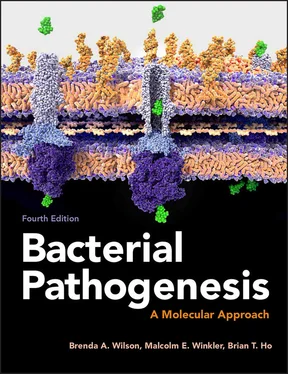Based on risk assessment, HACCP programs monitor the food and food safety practices at control points along the food production chain where contamination is most likely to occur. This approach not only lessens the likelihood that contaminated foods will be shipped, but also identifies contamination problems or situations that might lead to contamination early so that they can be rectified. At first the food industry was leery of the HACCP approach, viewing it as a needless and potentially expensive government intrusion, but the food industry has now become more enthusiastic about HACCP programs after seeing how expensive and injurious to the reputation of a company a large recall of contaminated products can be. A good HACCP program not only protects the public from disease, but also protects the company from recalls and lawsuits. Although there is still grumbling about specifics, the HACCP concept seems to be catching on.
Making Hospitals Safe for Patients
Fears concerning the prevalence of increasingly antibiotic-resistant bacteria have led to a number of changes in the way hospitals handle infectious disease cases. At one time, a surgeon could infect numerous patients and never even be informed of such incidents, let alone held accountable, due to lack of communication between physicians who care for patients during the postsurgical period and the surgeons who performed the operation. On top of that, hospitals with an infection control program would often delegate the job of infection control officer to someone of lower administrative authority who could not take action against doctors whose postsurgical infection record was poor or whose drug-prescribing practices were open to criticism. Now, this job is being taken much more seriously and is usually held by an infectious disease physician. Communication lines are also being improved.
Managed health care organizations, alarmed at the costs associated with infections involving antibiotic-resistant bacteria, have started cracking down on physician abuse or overuse of antibiotics. Ironically, cost-cutting measures by the health care plan bean counters, who had pressured physicians earlier to reduce drastically the number of laboratory tests they ordered, actually contributed to the resistance problem by encouraging physicians to use the strongest drugs available regardless of need. Thus, although there is still a certain amount of confusion and sending of contradictory signals between managers and physicians, awareness of the consequences have spurred positive changes in diagnostic and antibiotic prescription practices.
A somewhat less successful effort, so far, has been the campaign within hospitals to persuade health care workers to wash their hands after each patient and to implement other supposedly standard precautions, such as changing gloves when moving from one patient to another. Because many outbreaks of hospital-acquired infections likely spread by contact with health care workers, preventing transmission by this route has become an important priority. Unfortunately, health care workers have gotten out of the habit of washing their hands and instead rely on antibiotics. The high-stress atmosphere of a modern hospital, in which fewer health care workers are expected to treat more and sicker patients, has made it difficult to perform hygienic procedures by the book.
Now that antibiotics are becoming less effective, hygienic practices have become more important than ever, yet there is still considerable disparity among hospitals regarding compliance. An article published in the Wall Street Journal (April 5, 2006) described some of the methods used by hospitals to increase hand hygiene among health care workers. The methods included educational programs, monitoring of activities, disciplinary action, and even dismissal for failure to comply. A more recent trend, the use of alcohol-based antimicrobial gels by health care workers, is starting to make a difference because these gels are more effective than soap and water, require only 15 to 30 seconds of application, and, unlike soaps, do not cause skin dryness.
And Now for Some Good News: You’ve Got a Bacterial Infection!
Who would have thought that a person could be happy to learn that he or she had a bacterial infection? Yet, this is exactly what has happened to people suffering from ulcers and some other chronic infections. The doctrine for decades has been that infectious diseases are acute diseases that develop rapidly and run their course quickly, whereas chronic diseases—diseases that last for long periods of time without resolving—are caused by an autoimmune response, a genetic disorder, or some environmental factor. Examples of chronic diseases are heart disease, Alzheimer’s disease, and cancer. Now, one might ask the question: what if microbes caused these diseases and others like them? They might then be curable by antimicrobial agents or preventable by vaccines or other measures!
The discovery that many cases of liver cancer are caused by the hepatitis B virus made it possible to prevent this type of cancer by an antihepatitis B vaccine. Similarly, the discovery that most gastric and duodenal ulcers and some stomach cancers were caused by bacteria led to a revolution in the way patients with gastric diseases are now treated. More recently, cervical cancer was linked to the presence of human papilloma virus (HPV), and vaccination against HPV is now encouraged for women to prevent cervical cancer. Such examples have spawned a revolution that has led to the reinvestigation of virtually every chronic disease, from heart disease to schizophrenia, for possible microbial or viral origin.
The Helicobacter pylori Revolution
Not all is gloom and doom on the infectious disease front. Frustration over the inability of immunologists to find cures for autoimmune diseases or the inability of physiologists to find cures for heart disease has yielded to optimism as scientists begin to suspect that bacteria or other infectious agents may cause many of these diseases. To most people, taking lifelong medication that does not necessarily prevent the disease is not an acceptable “cure.” Because microbiologists have by far the best track record for cures, the new rallying cry has become “Let’s find the microbe that causes this intractable disease so we can cure it!”
The landmark that dramatically changed the way people think about chronic diseases was the discovery that most gastric inflammation and ulcers are caused by the Gram-negative bacterium H. pylori. This discovery led to a simple antibiotic combination therapy that cures gastritis and ulcers. Although some people have recurrences, the rate of recurrences is far lower than that for conventional treatments, which addressed the symptoms rather than the cause of the disease. Because having ulcers for a prolonged period increases the risk of developing gastric cancer, a particularly dangerous form of cancer, an effective treatment for ulcers should also help reduce the incidence of gastric cancer.
This discovery generated great enthusiasm among gastroenterologists, but when this information first came out, there was one major sector of the health care system that did not share in the celebration: the pharmaceutical companies. Ulcer medications, which had to be taken daily for life—costing patients thousands of dollars a year—were suddenly replaced by a single course of antibiotics that cost as little as $200 per treatment. Seeking to cut their losses, the pharmaceutical companies are now marketing their former prescription ulcer drugs as nonprescription heartburn medications.
The Aftermath
Getting the medical community to accept the idea that bacteria could cause ulcers took many years of acrimonious scientific debate, but once the idea was accepted, first by the research community and then by clinicians, it only took a short time for the world at large to understand that the implications of this discovery went far beyond ulcers. Suddenly, they recalled that if a disease is caused by a bacterium, then it could usually be cured with antibiotics, especially if diagnosed early enough. What followed was a veritable gold rush to find a bacterial cause for other diseases with unknown origins.
Читать дальше












